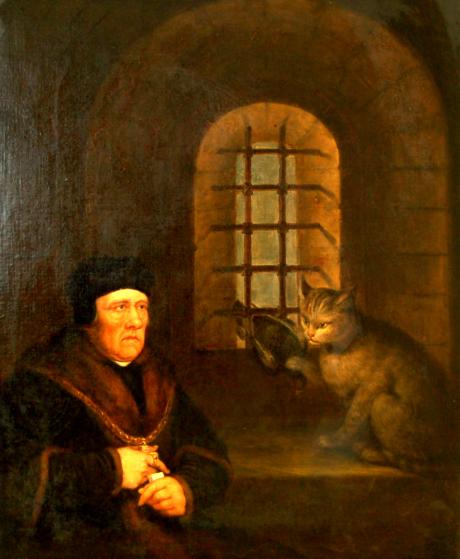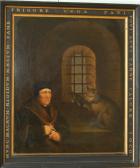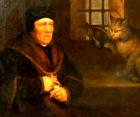Earl of Romney
Sir Henry Wyatt (c.1460–1536), politician and courtier, was a younger son of Richard Wyatt, of Yorkshire, and Margaret, the daughter and heir of William Bailif, of Reigate. His skill as a soldier and reliability as a financier made him one of the longest-serving courtiers of Henry VII and Henry VIII. His support for Henry Tudor began before 1483, and he probably participated in Buckingham's unsuccessful revolt against Richard III in that year. Family legend has it that he was imprisoned and interrogated by Richard III himself, and that during his imprisonment he was fed on pigeons brought to him by a cat. After the victory of Henry VII at Bosworth he received a number of grants and favours. In 1485 he became keeper of Norwich Castle and gaol, and before September 1486 he was made clerk of the king's jewels. He succeeded to the increasingly influential position of master of the king's jewels in June 1488, combining the office with that of clerk of the king's mint. By 1494 he was keeper of the change, assayer of the money and coinage, and comptroller of the mint. From these grants and offices came sufficient wealth to purchase in 1492 Allington Castle in Kent. Sir Henry retained his Yorkshire links, however, and in March 1487 he became joint bailiff and constable of Conisbrough Castle in Yorkshire. In June of that year he fought against the pretender Lambert Simnel in the battle of Stoke-on-Trent. He became governor of the city and castle of Carlisle in 1494, and at some point was captured and held to ransom by the Scots, for which he was reimbursed by a grant on 22 August 1515. This ‘two yeres and more prisonment in Scotland, in Irons and Stoks’ (Muir, 40), referred to by Sir Thomas Wyatt in a letter to his son, may have occurred between 1494 and 1496. By June 1496, however, Sir Henry wrote to the king from Carlisle to discuss preparations for putting down the rebellion of Perkin Warbeck, and in June 1497 he was present at the battle of Blackheath. About 1502 he married Anne Skinner. Thomas Scott's anecdotes of the family (BL, Wyatt papers, 29) present her as a powerful overseer of the household, who caught the abbot of Boxley in a compromising position with one of her maids, and stocked him. They had two sons, Thomas and Henry (who is assumed to have died in infancy), and a daughter, Margaret, who married Sir Anthony Lee, MP for Buckinghamshire. Her portrait by Holbein survives in the Metropolitan Museum of New York.
Sir Henry became a privy councillor in 1504, and was granted arms in 1507–8. He was an executor of Henry VII's will, and remained in high office in the reign of Henry VIII. Having been granted livery by virtue of his office as master of the king's jewel house at the funeral of Henry VII in May 1509, he was made knight of the Bath at the coronation of Henry VIII, and was appointed to the new privy council. He was commissioner of the peace for Middlesex and Surrey from 1509 to 1515. He established close ties with his Kentish neighbours the Boleyns of Hever Castle (Sir Henry became captain of Norwich Castle jointly with Thomas Boleyn in 1511), and with Thomas Cromwell, who became one of his executors. His military activity also ensured his continuing favour: with a retinue of 102 he accompanied the king to Calais in 1513, and was made knight-banneret after the battle of the Spurs in August 1513. In 1519 he again attended Henry VIII to Calais. In 1520 it fell to him to transport gold and silver plate sufficient for the banquet at the Field of Cloth of Gold. He attended Henry at Canterbury during his reception of Charles V in May 1522, and was by that date sheriff of Kent. By the later 1520s Sir Henry began to ease out of public life. He stood down as master of the jewels in 1524, and founded a chantry at Milton in Kent in that year; by 1528 he resigned as treasurer of the king's chamber and was succeeded by Sir Brian Tuke. By 1533 his retirement was complete, and his health was failing. In that year his son Thomas deputized for him as ewerer at the coronation of Anne Boleyn. From his retirement in Allington he learned of his son's imprisonment in May 1536, and wrote to thank both Cromwell and the king for his release. He died on 10 November of that year. His will provides for his burial at Milton ‘nere unto dame Anee my wyfe’ (TNA:
PRO, PROB 11/26, fols. 49v–50r) and for the continuance of his chantry there. A portrait by Holbein survives in the Musee du Louvre, Paris. and another, showing the cat supposed to have fed him during his imprisonment, is this portrait which was originally in the possession of the Earl of Romney, who was descended via the female line.
It is said by historians to have been the most beloved man in England. He was very close to Henry Tudor later Henry VII with whom he attended Eton, a matter whiich greatly disturbed Richard III who feared Tudor connection with the wealthy, much loved Wiatt. For this reason Richard III had Wyatt imprisoned in a tower in Scotland, where he was required to wear instruments of torture during the imprisonment. Denied of clothing, enough to keep warm, and food enough to survive, a cat named Acatar brought him a pigeon daily which kept him alive. After the Battle of Bosworthfield and the death of Richard III. Henry Wiatt was freed by his friend Henry Tudor and knighted. Lands and great wealth were his and he became the guardian of Tudor's son the future Henry VIII. He became Master of the King's Jewels and Treasurer of the King's Chamber. Allington Castle is the ancestral home of the Wyatt family and cats are welcome. SIR HENRY WYATT, the father of the poet, resisted the pretensions of Richard III to the throne, and was in consequence arrested and imprisoned in the Tower for two years. According to his son's statement he was racked in Richard's presence and vinegar and mustard were forced down his throat. There is an old tradition in the family that while in the Tower a cat brought him a pigeon every day from a neighbouring dovecot and thus saved him from starvation. There is no contemporary confirmation of the legend. The Earl of Romney, who is directly descended in the female line from the Wyatts, possesses a curious half-length portrait of Sir Henry seated in a prison cell with a cat drawing towards him a pigeon through the grating of a window. Lord Romney also possesses a second picture of 'The cat that fed Sir Henry Wyatt,' besides a small bust portrait of Sir Henry. The pictures, illustrating the tradition of the cat (now at Lord Romney's house, 4 upper Belgrave Street;, London), represent Sir Henry Wyatt in advanced years, and were obviously painted on hearsay evidence very long after the date of the alleged events they claim to depict. The Wyatt papers, drawn up in 1727 relate that Sir Henry on his release from the Tower 'would ever make much of cats, as other men will of their spaniels or hounds.' On the accession of Henry VII Wyatt was not merely liberated but was admitted to the privy council, and remained high in the royal favour. He was one of Henry VII's executors, and one of Henry VIII's guardians. Henry VIII treated him with no less consideration than his father had shown him. He was admitted to the privy council of the new king in April 1509, and became a knight of the Bath on 23 July following. In 1511 he was made jointly with Sir Thomas Boleyn [q.v.] constable of Norwich castle (Letters and Papers of Henry VIII, i, No. 3008), and on 29 July of the same year was granted an estate called Maidencote, at Estgarstone in Berkshire. At the battle of the Spurs he served in the vanguard (16 Aug. 1513). He became treasurer to the king's chamber in 1524, but resigned that office to Sir Brian Tuke on 23 April 1528. He had purchased in 1492 the castle and estate of Allington near Maidstone in Kent, and made the place his principal residence. Henry VIII visited him there in 1527 to meet Wolsey on his return from the continent. Wyatt remained friendly with Sir Thomas Boleyn (the father of Queen Anne Boleyn), who had been his colleague at Norwich, and resided at Hever Castle in Kent. Sir Henry died on 10 Nov. 1537 (Inq. post mort. 28 Hen VIII, m. 5), and, in accordance with his will, which was proved on 21 Feb 1537-8 (Cromwell, f.7), was buried at Milton, near Gravesend.
Henry Wyatt was a young cadet of the Lancastrian house, the youngest son of a Yorkshire squire of Southange in Yorkshire. In 1483 he became involved, as a stout Lancastrian in the Duke of Buckingham's unsuccessful revolt in the West Country in favour of Henry Tudor, Earl of Richmond, who was then in Brittany awaiting possible developments. In consequence Henry Wyatt was imprisoned in the Tower during the two years of the reign of Richard III, on whose orders he is said to have been tortured. He was only released on the death of King Richard and the accession of Henry VII. When the Standard of the fugitive Earl floated on the field of Bosworth, Wyatt found means to join it. When the Usurper had fallen on Bosworth field, one of the first acts of Henry VII was to liberate Henry and raise him from the private gentleman to the highest honours at Court. In 1485 he was rewarded by grant of “Keeper”, later to “Constable” for life of Norwich Castle. 1490 Master of the King’s Jewels for 34 years. 1488 Controller of the Mint, assisted with the reorganisation of the Mint and Coinage. He married Anne Skinner, late in life, in 1502. He bought Allington Castle from the trustees of Robert Gainsford in 1292. The castle was in bad repair, and Henry Wyatt and his son made extensive alterations. They put in large Tudor windows, erected a fine porch, a ladies bower, a new fire place , a long gallery, a new kitchen and a new staircase. Camden ascribes the credit of these alterations to Thomas Wyatt, but most of them seem to have been carried out by his father. 1492 Esquire-of-the-Body, King’s select Bodyguard. He sold Hall in the village Solhange (South Haigh or Upper Haigh) which he had acquired through his marriage to Margaret, daughter and heiress of Richard Bailiff of Barnsley, and purchased Allington Castle and restored it. Henry VIII visited him there in 1527, as did Cardinal Wolsey. 1491 Joint Executor of Henry VII’s will. 1494 Governor of the Castle of Carlisle to hold the border against the Scots 1513 -1515, then ransomed. 1500 Commissioner of the Peace for South East England. 1504 Was one of four who formed committee of the Privy Council to raise money for the King by the sale of offices, privileges and pardons.
Henry VII had died at the age of 52. He was succeeded by Prince Henry (VIII) to who Henry Wyatt had been guardian for some years. Henry Wyatt created Knight of the Bath at the Coronation 23 Jul 1509. Was one of the signatories for England of the Treaty of Scotland. Henry applied for a new grant of Arms in Jan 1507/8. The grant by Garter was made on the grounds simply that he was descended form the House of Blood and name of the Wyatts' He was a privy councillor and may not have been called upon by Garter to produce a pedigree any more than his acquaintances Cardinal Wolsey or Thomas Cromwell when they applied for Armorial Bearings which they had not inherited. In the Rolls of Roger Twysden the pedigree shows five generations back to an Adam Wyot, who lived in the middle of the 14 Century in Yorkshire. In 1512 he was appointed joint constable of Norwich Castle with Sir Thomas Boleyn, (father of Anne Boleyn). In 1513 Wyatt conducted Suffolk from France to the Tower where he was executed by Henry VIII. Sir Henry was made Knight Banneret for his services at the Battle of Spurs in 1515, and was present at the Field of the Cloth of Gold. As Treasurer of the King’s Chamber raised and sent £20,000 to King’s Army on the Scottish Border in 1522. About 1526, Henry Wyatt had official lodgings in the Royal Palace as member of the Select Body of the Privy Council to hear complaints of the King’s subjects. When lesser monasteries were dissolved Wyatt obtained lands and tenements in Essex and land in Milton (near Faversham in Kent) where he established the “Henry Wyatt Chantry” Resigned posts of Treasurer of the King’s Chamber and the Royal Mint in 1528. Henry Wyatt died at Allington Castle in Nov 1536 nearly 80 years old and was buried at Milton, Gravesend.



